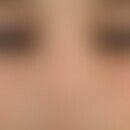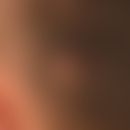Synonym(s)
HistoryThis section has been translated automatically.
DefinitionThis section has been translated automatically.
You might also be interested in
ClassificationThis section has been translated automatically.
One can distinguish a primary (idiopathic) cutis verticis gyrata with and without associated symptoms and a secondary cutis verticis gyrata.
Occurrence/EpidemiologyThis section has been translated automatically.
Worldwide the occurrence of cutis verticis gyrata has been described in 0.5-3.4% of all mentally retarded people. The etiology of cutis verticis gyratais is still unknown, although genetic and endocrinological factors of pathogenetic relevance are suspected. Furthermore, a connection between steroid abuse and the development of cutis verticis gyratais has been demonstrated.
ManifestationThis section has been translated automatically.
- Primary form: During or after puberty, in 90% of patients before the age of 30. Men are affected 5 times more frequently than women.
- Secondary form: Depending on the underlying disease, often at birth or during the first years of life.
LocalizationThis section has been translated automatically.
ClinicThis section has been translated automatically.
Bead-shaped wrinkles up to the thickness of a finger. Possibly reduced hair growth on the skin folds. Possible maceration and superinfection in very dense folds. The primary form is often associated with mental retardation, neurological deficits, or ophthalmologic changes, such as cataract, strabismus, or retinitis pigmentosa. Cases of cutis verticis gyrata with hyper IgE syndrome have been described.
Differential diagnosisThis section has been translated automatically.
TherapyThis section has been translated automatically.
A causal therapy of the disease is not known. If necessary excision, clarification and treatment of the accompanying symptoms.
Progression/forecastThis section has been translated automatically.
LiteratureThis section has been translated automatically.
- Audry C (1909) Pachydermia occipitale vorticalée (cutis verticis gyrata). Ann Dermatol Syphiligr (Paris) 10: 257-258
- Cribier B et al (1993) Cutis verticis gyrata: reduction surgical treatment. Ann Dermatol Venerol 120: 542-545
- Fesel R et al (1990) Cutis verticis gyrata. dermatologist 41: 501-505
- Jadassohn J (1906) A peculiar furrow, widening and thickening of the skin at the back of the head. Verh Dtsch Dermatol Ges, IX Congress, p. 451
- Nguyen NQ (2003) Cutis verticis gyrata. Dermatol Online J 9: 32
- Schöttler L et al (2007) Cerebriforms asymptomatic furrows of the scalp. dermatologist 58: 1058-1062
- Snyder MC et al (2002) Congenital primary cutis verticis gyrata. Plast Reconstr Surgery 110: 818-821
- Unna PG (1907) Cutis verticis gyrata. Practical Dermatol 45: 227
- by Geest AJ et al (2002) Cerebriform intradermal naevus (a rare form or secondary cutis verticis gyrata). J Eur Acad Dermatol Venereol 16: 529-531
- Woollons A et al (2000) Cutis verticis gyrata of the scalp in a patient with autosomal dominant insulin resistance syndrome. Clin Exp Dermatol 25: 125-128
Incoming links (23)
Acanthosis nigricans maligna; Acromegaly; Audry syndrome; Bull-dog-scalp syndrome; Cutis capitis gyrata; Cutis gyrata unna; Cutis verticis plicata; Hyper IgE syndrome 1; Klinefelter's syndrome; Lipomatosus nevus generalisatus; ... Show allOutgoing links (6)
Amyloidosis (overview); Excision; Michelin tire baby syndrome; Neurofibroma; Nevus melanocytic (overview); Pseudocutis verticis gyrata;Disclaimer
Please ask your physician for a reliable diagnosis. This website is only meant as a reference.









